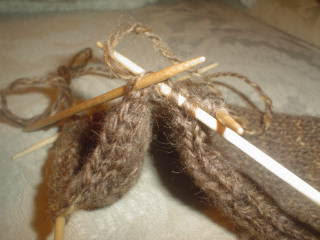
Here is Gwendolyn. She's a moorit Shetland ewe who has really nice conformation and a lovely fleece (striking her model's pose here!). She does not have the variation of fiber I'd like to see to make her a believable purebred Shetland (that means her crimp is pretty consistent from neck to tail, which resembles commercially bred sheep.) Other than that, her wool makes for lovely socks!

So of course, I had to make MORE socks! This time, I added a rim around the cuff. That yarn is (gasp!) a synthetic yarn! Gulp! Yep. I used it. It is left over from a project I knitted before I had my own sheep, or could spin my own yarn. I love using a contrasting color just for the cuff for visual appeal. I also like how easy these socks are to pull on or off in a hurry. In this picture, I've knitted to top of the sock and already turned the heel. Here I am just picking up those stitches on the heel flap to begin knitting in the round again for the gusset decreases. When I first learned how to do this, I thought it was so hard! But each sock I made (and a few screw-ups along the way), got better. Now it's not only easy, but one of my favorite parts of knitting the sock.

There are different ways of doing this step, and everyone has their favorite. Once you learn it, you can fly along here and have it done in a minute or two. Here, the right needle is inserted into the next stitch being picked up, and the yarn is wrapped around, ready to be pulled through the stitch. That little curve on fabric under the needles on the left is where the heel will sit in the sock.
Gwendolyn's wool was spun worsted weight, so this will be a wonderful armor against the cold this winter. Bring on the cold weather and let's get it over with! I'm ready with all my warm, soft socks!
ONE OF THESE DAYS, I'm gonna try socks....
ReplyDeleteSo, judging by the pink accent yarn, I guess these aren't for me! I could use a few more pairs! Maybe I'll find some under the tree this Christmas???
ReplyDeleteDH ;-)
You should Nancy! Once you get started, it's hard to stop. :)
ReplyDelete